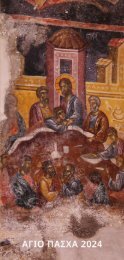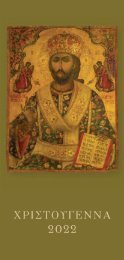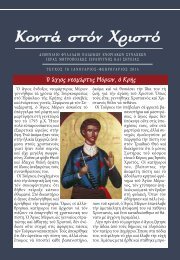Create successful ePaper yourself
Turn your PDF publications into a flip-book with our unique Google optimized e-Paper software.
68<br />
Manuel Phokas, such as St. George in Embaros and St. Constantine at Avdou, should be<br />
placed a little before the middle of the 15th century.<br />
The wall painting decoration of the transept, which was completed in 1453, the year of<br />
the Fall of Constantinople, is the last confirmed work of the painter Manuel Phokas, while<br />
it is part of the so-called academic current of the Palaeologan period. The iconographic<br />
programme of the church includes, in the original aisle, scenes from the Gospel cycle with<br />
emphasis on the miracles of Christ, three of which are depicted on the barrel-vault of the<br />
main church, as well as the scene in front of the Magistrate from the life of St. George.<br />
Scenes from the Twelve Great Feasts and the cycle of the saint were added later to the<br />
transept, whose wall paintings are partially preserved.<br />
The monastery of Kapsas is located in the southerneast corner of Crete, on the west<br />
side of the exit from the gorge of Pervolakia towards the sea. Even though the date<br />
of its foundation is unknown to us, the existence of wall painting decoration, possibly of<br />
the 13th–14th centuries, in the aisle of St. John the Forerunner, as well as the engravings<br />
HOLY<br />
MONASTERY<br />
OF KAPSAS<br />
which cover a long period, the oldest from 1512 until the more recent in<br />
the 18th century, give us secure facts for an early dating of the monument.<br />
The existence of a small monastery, at least, is also demonstrated by<br />
testimonials, according to which there were two ruined cells next to the<br />
church during its reestablishment in the middle of the 19th century.<br />
The contemporary history of the monastery is<br />
inextricably linked to John Vitsentzos or<br />
Gerontogiannis, who in 1844, decided to<br />
become a monk in the area, originally living as<br />
an ascetic in an adjacent cave for seventeen<br />
years and later repairing the existing cells. The<br />
sanctity of his life and his fame drew other<br />
ascetics, resulting in the creation of a monastic<br />
community and the construction of additional<br />
buildings. After the passing of Gerontogiannis,<br />
his grandson, Joseph Gerontakis, who became<br />
the abbot of the monastery in 1866, continued<br />
the construction work of his predecessor, as<br />
can be confirmed from the inscription on the<br />
entrance to the catholicon, of 1882, which<br />
mentions both the first donor, Gerontogiannis,<br />
and Joseph. The building complex of the<br />
monastery develops incrementally due to the<br />
sloping ground of the steep slope, with the<br />
cavernous church of St. John as the centre,<br />
which is formed externally as a twin-naved,<br />
barrel-vaulted church. The grave of The Holy Forerunner.<br />
Gerontogiannis, who was officially included in<br />
the list of saints of the Orthodox Church in the year 2004, is located in the interior, in the<br />
southwest corner.<br />
Excellent icons of the Cretan School are preserved in the church, such as the All-Holy<br />
Virgin the Vrefokratousa, in the type of the Dexiokratousa [‘holding the Child on the right’],<br />
of the beginning of the 15th century, and St. John the Forerunner of the 16th century.<br />
69<br />
Atwin-naved church was added to the south side of the single-nave church of the<br />
All-Holy Virgin, in the middle of the settlement, during the 1950s. The wall<br />
painting decoration of the old aisle, of the 14th century, has scenes from the Christological<br />
and Marian cycles with the scene of the Second Coming occupying the entire west wall.<br />
The representations of Christ on the south wall and of the All-Holy<br />
Virgin Vrefokratousa [‘holding the Child’] on the north, next to the altar<br />
screen, have the place of pilgrimage icons. The floor of the church made<br />
from hexagonal limestone tiles, which date to the Venetian period, as<br />
well as the series of glazed bowls on the exterior side of the south wall, are of interest.<br />
ALL-HOLY VIRGIN<br />
AT LITHINES


















